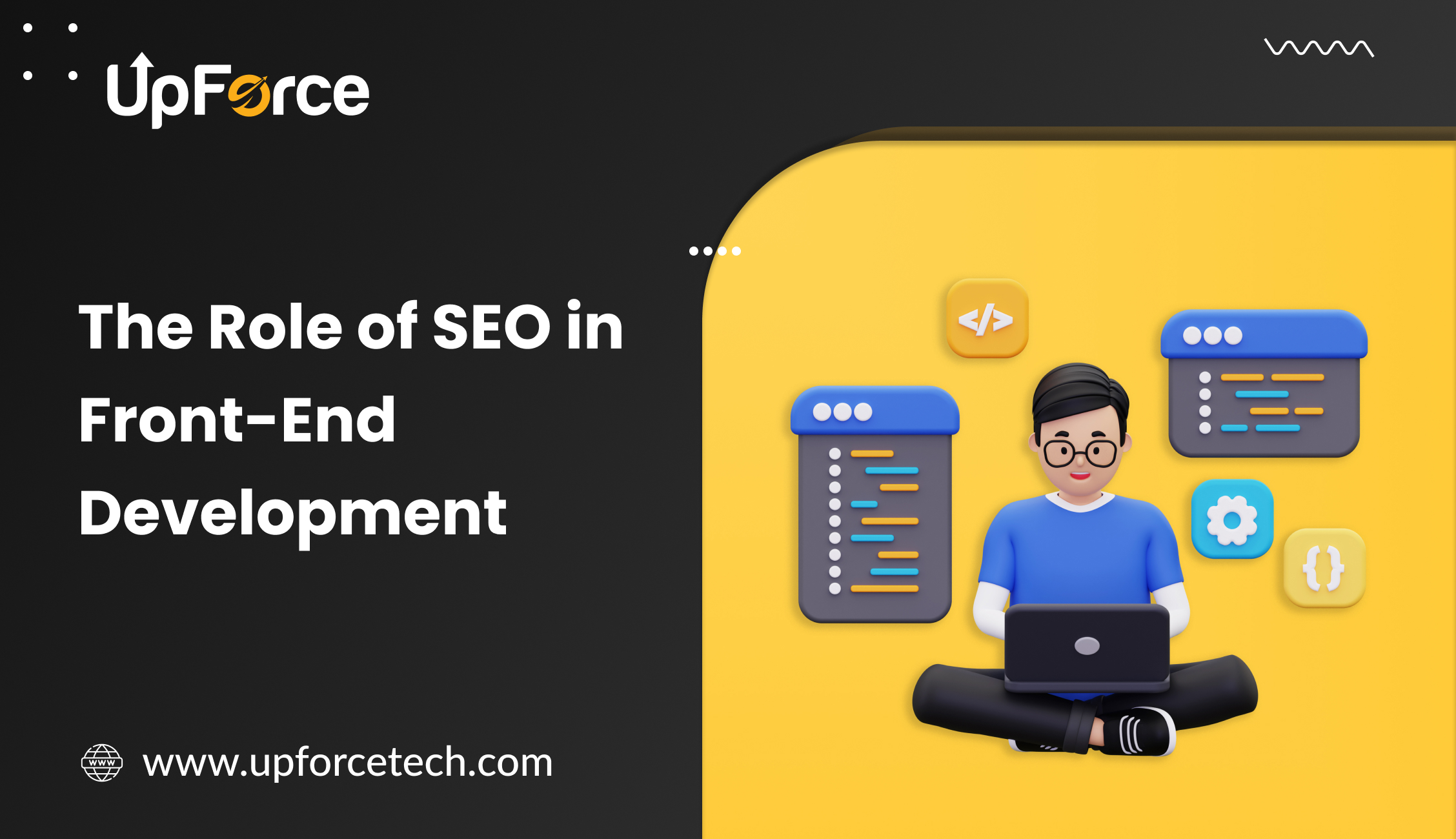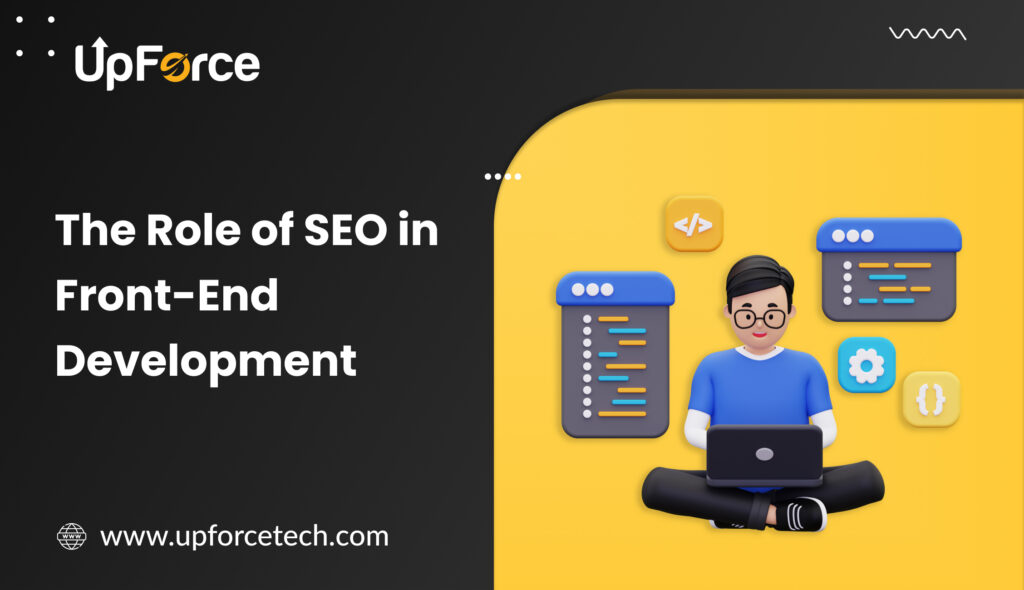The Role of SEO in Front-end Development: A Complete Guide

The Role of SEO in Front-end Development: A Complete Guide
In today’s digital landscape, a well-designed website is only half the battle. To truly succeed, a website must also rank high on search engines, which is where Search Engine Optimization (SEO) plays a crucial role. For front-end developers, SEO should be a core consideration when building websites. In this guide, we will explore the essential role of SEO in front-end development and provide actionable insights to enhance your website’s visibility and performance.
Why SEO Matters in Front-end Development
Search engines are the gateway to the internet. Most users rely on them to find content, services, and products. By optimizing your website’s front-end, you can improve your ranking on search engines, which in turn, drives more organic traffic.
Front-end developers influence many elements that search engines consider when ranking pages, such as website speed, mobile responsiveness, structure, and user experience. Thus, having a solid grasp of SEO is critical for delivering effective and user-friendly websites.
AI in software development is not just about automation; it’s about enhancing human capabilities, allowing developers to focus on more creative and strategic tasks. From code generation to bug fixing and beyond, AI is reshaping the development landscape in remarkable ways.
Understanding SEO in Front-end Development:
- Think like a user: Create a website that’s easy to navigate and visually appealing.
- Speed things up: Optimize images, minimize code, and leverage browser caching.
- Keep URLs simple: Use clear, descriptive URLs that are easy to remember.
- Write compelling titles and descriptions: Grab attention with catchy headlines and informative summaries.
- Structure your content: Use heading tags (H1, H2, etc.) to organize your information.
- Describe your images: Add alt text to help search engines understand visual content.
- Link wisely: Connect related pages within your website and link to reputable external sources.
- Make it accessible: Ensure your website can be used by everyone, including those with disabilities.
- Keep your content fresh: Regularly update your website with new and relevant information.
- Track your performance: Use tools like Google Search Console to monitor your website’s search engine rankings.
- Stay informed: Keep up with the latest SEO trends and best practices.
- Collaborate with your team: Work with back-end developers to ensure your website is optimized from all angles.
Key SEO Principles in Front-end Development
Here are some of the essential SEO aspects that front-end developers should prioritize:
1. Website Speed Optimization
One of the critical ranking factors for search engines like Google is website speed. A slow website can result in a poor user experience and higher bounce rates, directly affecting your search ranking.
Tips for Speed Optimization:
- Minimize HTTP requests by reducing the number of elements on a page.
- Optimize images by using the correct formats (WebP, JPEG), resizing, and compressing them.
- Minify CSS, JavaScript, and HTML to remove unnecessary characters and improve load times.
- Leverage browser caching to store files locally for faster repeat visits.
Case Study: E-Commerce Website Speed Improvement
An e-commerce website experienced high bounce rates and low conversions. After implementing image optimization and minifying CSS and JavaScript, the website’s load time improved by 50%. As a result, the bounce rate decreased by 30%, and conversions increased by 20%.
2. Mobile-first Design and Responsive Layouts
With the majority of internet users accessing websites from mobile devices, Google prioritizes mobile-first design. Mobile responsiveness ensures your site performs well across all devices, which boosts both user experience and SEO.
Key Points for Mobile-first Design:
- Use media queries to adjust layouts for different screen sizes.
- Ensure tap targets (like buttons and links) are appropriately sized for touch devices.
- Optimize font sizes for readability across devices.
- Ensure CSS frameworks like Bootstrap or Tailwind are mobile-friendly.
Example: Mobile Optimization Success
A news website redesigned its site with a mobile-first approach. The new design ensured content loaded quickly and was easily readable on mobile devices. This change led to a 40% increase in mobile traffic and a 25% improvement in user engagement.
3. Clean HTML Structure and Semantic Markup
Search engines rely on HTML structure to understand the content of a web page. Using semantic HTML tags provides a clear hierarchy of content, making it easier for search engine crawlers to index your site correctly.
Best Practices for Semantic Markup:
- Use header tags (H1, H2, H3, etc.) correctly to establish a content hierarchy.
- Add alt attributes to images to help search engines understand image content.
- Utilize meta tags for titles and descriptions to improve click-through rates (CTR) on search results.
- Implement schema markup to enhance rich snippets, such as reviews, ratings, and FAQs.
Case Study: Improved SERP Visibility
A local business implemented schema markup on their product pages. This resulted in rich snippets displaying ratings and prices directly in search results. The business saw a 50% increase in organic traffic and a 35% increase in click-through rates.
4. URL Structure and Internal Linking
A well-structured URL is easy to read by both users and search engines. URLs should be descriptive, concise, and include relevant keywords. Internal linking helps distribute page authority and allows search engines to navigate your website more effectively.
Key Strategies for URL Structure:
- Keep URLs short and descriptive with focus keywords.
- Use hyphens to separate words in URLs instead of underscores.
- Implement a logical hierarchy in URL structures (e.g., /services/web-development).
Best Practices for Internal Linking:
- Use descriptive anchor text that includes relevant keywords.
- Link to high-authority pages to help search engines distribute page authority.
- Ensure there are no broken links on your site to avoid penalties.
Example: Internal Linking Impact
An online retailer improved their internal linking strategy by adding links to related products and blog posts. This adjustment increased the average page views per session by 20% and reduced the bounce rate by 15%.
5. JavaScript SEO Considerations
JavaScript is widely used in modern front-end development. However, poorly implemented JavaScript can block important content from being crawled by search engines, hurting SEO performance. Ensuring that search engines can render your content is crucial.
JavaScript SEO Tips:
- Avoid excessive use of JavaScript-heavy content that loads dynamically, as it may not be crawled properly.
- Ensure critical content is server-side rendered (SSR) or prerendered when possible.
- Use tools like Google Search Console to check if search engines are rendering your JavaScript correctly.
- Implement lazy loading for images and videos to improve page speed without sacrificing content.
Case Study: JavaScript Rendering Solution
A SaaS company faced issues with their JavaScript-heavy website not being properly indexed by search engines. By implementing server-side rendering and using tools like Google Search Console, they improved their indexing and saw a 40% increase in organic search traffic.
6. Meta Tags and Structured Data
Meta tags like title and description tags play a vital role in SEO. They help search engines understand the content of your pages and determine how to display your site in search results. Structured data, like schema.org, enhances how your pages appear in rich snippets, which improves click-through rates.
Meta Tag Best Practices:
- Title tags should be unique, descriptive, and include your focus keyword.
- Meta descriptions should summarize your page content in 150-160 characters, including relevant keywords.
- Use structured data to help search engines display rich snippets, such as reviews, product details, and FAQs.
Example: Meta Tags Optimization
A tech blog optimized their meta tags by ensuring each page had a unique and descriptive title and meta description. This led to a 30% increase in organic search traffic and a 20% improvement in click-through rates.
7. Accessibility (A11Y) and SEO
Improving website accessibility not only helps users with disabilities but also enhances SEO. Search engines prioritize websites that offer a great user experience to everyone.
Tips for Enhancing Accessibility:
- Use ARIA (Accessible Rich Internet Applications) roles and attributes to make dynamic content accessible.
- Ensure images, forms, and buttons have descriptive alt text or labels.
- Implement keyboard navigation to help users with disabilities navigate your website.
Case Study: Accessibility Improvements
An educational website improved accessibility by adding ARIA labels and optimizing keyboard navigation. This led to positive feedback from users with disabilities and a 15% increase in search engine visibility.
8. Content Optimization and User Experience (UX)
High-quality content that is relevant to the user’s search query is one of the most important ranking factors. In addition to being informative, your content should be easy to read and structured in a way that engages users.
Content and UX Tips:
- Use keywords naturally throughout your content to avoid keyword stuffing.
- Break content into short paragraphs and use bullet points for better readability.
- Include multimedia such as images, videos, and infographics to make content engaging.
- Ensure your website has clear navigation to improve user retention.
Example: Content Optimization Success
A travel website revamped their content strategy by incorporating relevant keywords and using engaging visuals. This resulted in a 50% increase in time spent on the site and a 25% boost in search engine rankings.
How UpforceTech Can Help You Hire the Right Contract Developer
At UpforceTech, we specialize in connecting businesses with highly skilled contract developers who can meet their unique needs. Our rigorous vetting process ensures that you get access to the best talent, whether you need someone with expertise in front-end development, back-end systems, or mobile app development.
Here’s how UpforceTech can support your business:
- Access to a Global Talent Pool: We provide access to a diverse range of developers from around the world, ensuring you find the right fit for your specific project needs.
- Customized Hiring Solutions: Whether you’re looking for short-term contract developers or long-term project-based teams, we tailor our services to fit your requirements.
- Quality Assurance: Every developer in our network goes through a comprehensive screening process to ensure they have the necessary skills and experience to deliver high-quality work.
- Ongoing Support: Our commitment doesn’t end with hiring. We offer ongoing support to ensure a seamless integration of contract developers into your team.
For more information on how to get started with hiring contract developers, visit UpforceTech.
Looking to boost your business with skilled developers? Hire a contract developer today to bring fresh ideas and expertise to your team. Learn how UpforceTech can help!
Sign up for the free Newsletter
Good SEO is not just about ranking higher on search engines—it's about creating a seamless user experience that delights your visitors and keeps them coming back.
UpforceTech
FAQs
SEO in front-end development involves optimizing a website's design, structure, and content to improve its visibility on search engines. This includes ensuring fast load times, mobile responsiveness, and clear, keyword-rich content. Effective SEO practices help attract more organic traffic and enhance user experience.
SEO directly impacts website load times by emphasizing the need for optimized images, minified code, and efficient server responses. A faster-loading site improves user satisfaction and can lead to better search engine rankings, as search engines prioritize speed in their algorithms.
Mobile responsiveness is crucial for SEO because search engines, like Google, prioritize mobile-friendly websites in their rankings. A responsive design ensures that your website performs well on all devices, providing a better user experience and improving your chances of ranking higher in search results.
Front-end developers can improve a website's SEO by implementing best practices such as optimizing page load speed, using semantic HTML, creating a responsive design, and ensuring that all images have descriptive alt text. They should also ensure that internal linking is effective and that the site structure is easy to navigate.
Common SEO mistakes in front-end development include not optimizing images, using poorly structured HTML, neglecting mobile responsiveness, and failing to implement meta tags and header tags properly. Avoiding these mistakes helps ensure that a website is search engine-friendly and user-friendly.
Semantic HTML contributes to SEO by providing clear, meaningful tags that help search engines understand the content of a webpage. Tags like <header>, <footer>, and <article> help search engines index content more accurately and improve overall site structure and accessibility.
Meta tags play a critical role in SEO by providing search engines with information about a webpage's content. Properly using meta tags, such as meta descriptions and meta keywords, helps search engines understand and index your content, potentially improving your rankings and click-through rates.
Front-end developers can use keywords effectively by incorporating them naturally into page titles, headers, meta descriptions, and throughout the content. Ensuring that keywords are used in a way that enhances readability and relevance improves the likelihood of ranking well in search results.
A clean URL structure is important for SEO because it makes URLs more readable and user-friendly. Clean URLs, which include relevant keywords and are free of unnecessary parameters, help search engines understand the content of the page and can improve click-through rates from search results.
Front-end developers can ensure a website is accessible for SEO by following best practices for web accessibility. This includes providing descriptive alt text for images, using proper HTML markup, ensuring color contrast is sufficient, and making sure the site is navigable with a keyboard. Accessibility improvements often align with SEO best practices, leading to better rankings and a more inclusive user experience.

